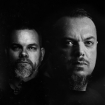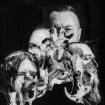The ritual of pain unfolds before midnight. It's a sold-out Halloween night show at the Ancienne Belgique concert hall in Brussels, where singer Colin H. van Eeckhout stands silent and shirtless as attendants carefully pierce his flesh with meat hooks. He's being punctured like the martyr Saint Sebastian, and shares the stage with his brooding post-metal band Amenra, four musicians in black flooding the room with a low rumble of tone and feedback, melody and dread. As small stones are attached to the hooks penetrating the singer's back, chest and arms, a trickle of blood drips from his wounds.
The music begins to swell with raw, thundering guitars, and Van Eeckhout turns away from the congregation of 2,000 Belgians to kneel on the stage. The song is "Terziele Tottedood," from 2008, and soon the singer is taking deep breaths, shaking his head violently, rising to scream in West Flemish a message of agony and punishment: "My soul splits and I see no blood/I do not know how to heal/Hooks of iron and regret/I do not know how to live."
During one performance in 2013, the singer was suspended from hooks high above the stage, hovering Christ-like with arms outstretched. This night is more about endurance, with the stones pulling heavily at his skin. This is also Amenra's longest-ever performance at just past 90 minutes, roaring beyond the venue's curfew to celebrate the release of a new album, Mass VI. That counts as a high holy day for the band's mysterious Church of Ra, their collective of artists, filmmakers, photographers and musicians with a similar taste for the shadowy and loud. The concert also embodies what has made Amenra one of the most fascinating and galvanizing groups active in heavy music — their records and performances aren't mere entertainment; they're rituals aimed towards transcendence. Mass VI is Amenra's first album of new material in five years, though the band has been active during that time, both together and apart, on the road and off. There was a live album in 2016, acoustic gigs, film scores and solo projects. What brought them back together to write another wrenching Mass of melody and rage was life experience, the ongoing accumulation of crisis and tragedy.
"It's not hard to write heavy music, but it's hard to write heavy music that feels necessary or feels useful in our personal lives," Van Eeckhout explains later.
First came the cancer diagnosis and death of drummer Bjorn Lebon's mother. Another band member suffered from the unhappy end of a romantic relationship; one more had what the singer describes sympathetically as "an existential crisis." Then Van Eeckhout's six-year-old son was diagnosed with a brain tumor, an event that overwhelmed the singer's life for a time, an agonizing experience explored on the 11-minute "Diaken" that closes Mass VI with a grinding wall of sound and feeling.
"Whenever you encounter a moment like that, a helpless situation, you are fucking alone as can be," Van Eeckhout says. "Nothing can help you except yourself. And that will decide how you will live through the moment." (His son's operation was a success but, as he speaks, the boy is due for a follow-up procedure in another month.)
At the heart of Mass VI is "A Solitary Reign," a nine-minute epic that spans a range of sound and fervor, from growling guitars to delicate moments of melody as Van Eeckhout rages and whispers: "I retraced/My steps to your embrace/I wanted you to stay/Yet you died away." Its lyrics ruminate on loss and imagine a final goodbye to a mother, "asking her to sing you to sleep one more time."
The music unfurls through bruising waves of sludge and clarity, creating long, darkly cinematic pieces of music through the riffs and beats of guitarists Mathieu J. Vandekerckhove and Lennart Bossu, new bassist Levy Seynaeve and Lebon. Within that wall of thunder, Van Eeckhout is the exposed nerve through vocals that shift from reserved to intense, erupting with screams that are strangely musical.

"A scream needs to hurt," Van Eeckhout explains. "A scream needs to come from within. When something in the street happens, and you hear a genuine scream, everybody stops, everybody looks around and brings the world to a halt. That is the function of a scream. That is why people should scream on music, to address certain feelings from within that every human being has. Every human being has moments in life where he wants to scream out loud and lose it.
"I think we're lucky we have this as a medium to keep us in balance. I always compare it to going to a shrink every week. We don't go to a shrink, but we do a show for an hour. We don't sit there and talk about our darkest fears in life to another human being, but we sing them."
On the cover of Mass VI is the picture of a dead swan, still elegant in its coat of white feathers and a red beak. Its connection to the band can be read within the Dutch phrase "zwanenzang," the swan song. "Everything beautiful comes to an end. It still has its beauty, and it still has its grace within that moment," he says. "It's like the last dance. We've been around for almost 20 years now. We realize that every album we do now could be our last. You never know what will happen with you. Since day one of Amenra, it has been a long farewell. We've been saying goodbye since album number one."
The new album was recorded with American producer Billy Anderson (Neurosis, Melvins) amid the snowy forests of the Belgian Ardennes. By the time Amenra entered the studio, songs were fully written and arranged in detail, leaving the sessions focused on performance, capturing texture and emotion. The result is heavy on atmosphere, fueled on minimal riffs played at maximum intensity.
For Van Eeckhout, the physical experience of being onstage with Amenra is equally essential. As a young man, he began exploring pain and shaping his body through tattoos, piercings and scarification. "As soon as I saw some photographs of that stuff it intrigued me. I knew that was something I related to," he says.
"The moment that I decided that I was going to do the first one was when my dad died when I was 20 years old. I knew that was my way of probably marking that moment and it might have been my way into being able to lose myself and going up there and shake his hand again and say goodbye." Now with Amenra, he continues, "I want to be the visualization of overcoming pain, of taking that pain and making it yours and moving on."

To that end, along the full length of his back, the singer has an ominous tattoo of the Todesrune, an old German symbol for death. On his body are messages written in ancient Theban script, including the words "past" and "future" on opposite arms. He's also had his nipples surgically removed. The ritual of enduring meat hooks and suspensions during his performances is not meant as theater or shock rock, but as a way to connect deeper with the extreme emotions of the music.
"For the first time in my life, I felt a force within the music that I hadn't felt before — a medicating aspect of it, a healing aspect of it," he says of the suspensions. "I know it's a thin line when you do that stuff on a stage. But it is a fact that when real blood is involved, it becomes real. The moment of that concert becomes undeniably dangerous. Some people fainted or some people reacted by saying it wasn't necessary. Of course, it wasn't necessary for the show, but we don't give a rat's ass about the show.
"It is necessary. It is important for me."
Removing his nipples was neither impulsive or a decision years in the making. It was another physical threshold to be crossed, and he had an artist friend encase his now-detached body parts in transparent resin and ornamental silver, so that he can one day give them as lasting physical relics to his two sons.
"The nipples are also the symbol of nurturing, breastfeeding a child and stuff," he says. "I could have taken off fingers as well for that matter but the nipples made more sense to me. It makes perfect sense in my head, but if I start talking about it out loud, it seems so out there. It's doing things within that surpass your own boundaries, doing things that you think you cannot handle."
The roots of Amenra go back to the Belgian hardcorescene that Van Eeckhout and Vandekerckhove discovered as teen skate kids, reading Thrasher magazine and obsessing over Black Flag and Suicidal Tendencies. They were drawn to the local straight-edge hardcore scene and began making loud music of their own, sneering about revolution and celebrating their community of drug-free punks.
Van Eeckhout remembers that time as an important setting of learning and brotherhood. "You're 16 years old, you wanna prove to the world how tough you are, but you don't know shit about anything," he recalls fondly. "But it formed us and then we just switched it around and suddenly I realized, maybe I should start singing and writing about the things that I actually deeply care about and move me."
As the Belgian hardcore scene drifted toward metalcore, the singer gravitated instead toward Refused, Breach and other adventurous acts breaking far from the usual hardcore formulas to create something new and original. Then they encountered the blazing psychedelic thunder of Neurosis and the progressive metal of Tool, and saw the possibilities for their own music open up for them.
The connection to Neurosis was especially profound.
"The first time I saw them in '94 or '95, my mouth really fell open," says Van Eeckhout. "It was the first time I was semi-scared at a show. They were so animalesque, instinctive, attacking everything around them with sound. That blew my mind. That opened my eyes: Holy shit, this is possible." (The connection lives on: Mass VI is released on the Neurosis-owned Neurot label.)
Beginning with 2003's Mass I, their albums have charted Amenra's evolution towards songs and ceremony that tap into the darker corners of human suffering and relief. "We never considered ourselves metal," he insists. "We've always considered us hardcore kids. Metal? I don't know. We're post-metal now. It's like we skipped the metal part." Followers of the band feel the same depth of emotion, and show it when communicating with Amenra. The feelings can be overwhelming.
"We have people crying at the merch table in our arms," Van Eeckhout says. "You get the most beautiful gifts, especially the testimonies from around the world. You feel they need to do it. They need to tell their story and why it meant so much and what song and what part of the lyrics. That makes it really special and out of this world." In that way, Van Eeckhout feels like Amenra is creating something lasting, a connection of spirit within their Church of Ra. He is not religious but recognizes the power of ritual for both performer and audience.
"You want it to mean something, not only for ourselves, but you want it to mean something to people even after we are gone," he says. "It's up to every individual human being to decide whatever he will find solace in or find comfort or find hope in. That is what I advocate for. That is what makes me spiritual or whatever the fuck I may be. It's interesting to work with. It's interesting to hand over to people as a possibility."











